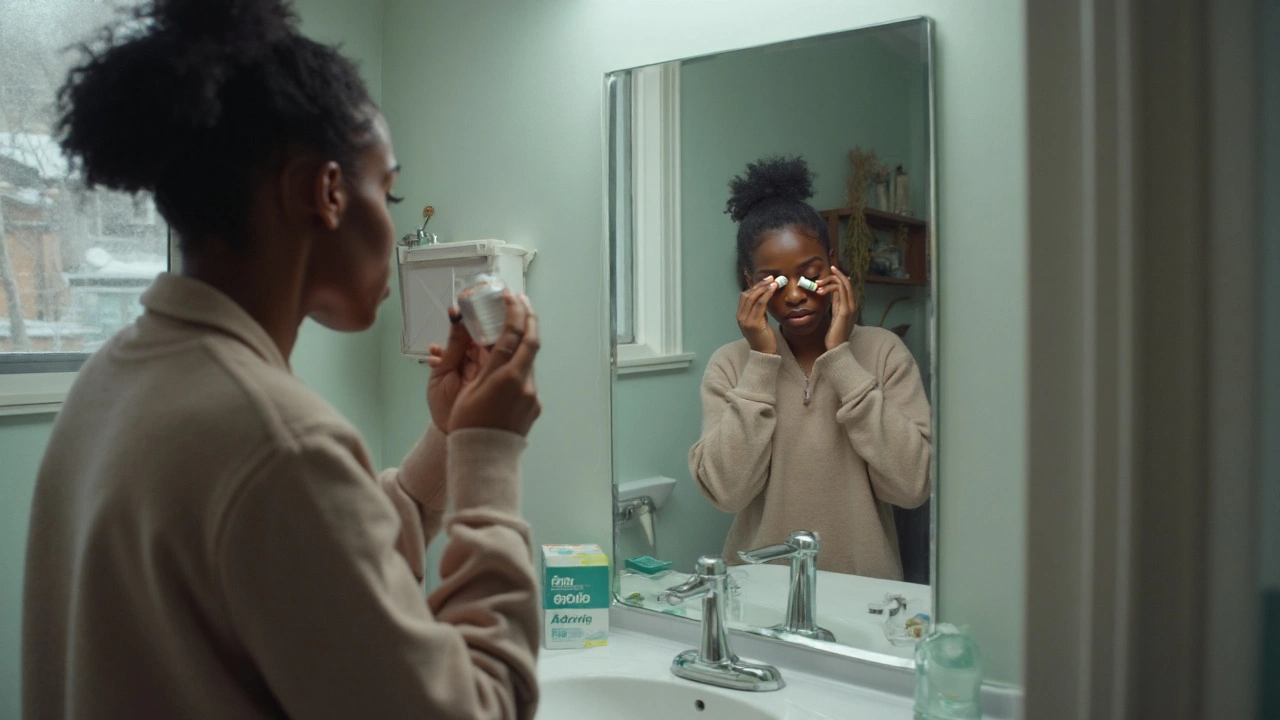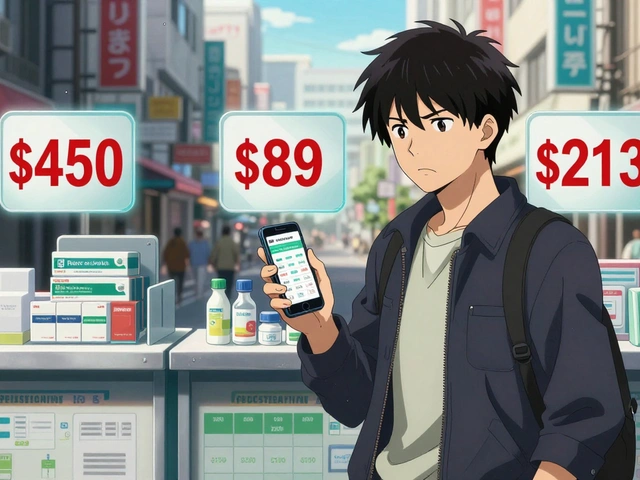
Glaucoma steals sight quietly. The fastest way to slow it down is lowering eye pressure, and that’s exactly where Dorzolamide-Timolol earns its place. If your pressure stayed too high on a single drop, or you couldn’t tolerate it, this fixed combo often cuts pressure enough to protect your vision. It isn’t a cure and you won’t “feel” it working, but the data behind it is solid-provided you use it right and it’s safe for you.
- What it is: Two meds in one bottle-dorzolamide (a carbonic anhydrase inhibitor) + timolol (a beta blocker)-that lower intraocular pressure (IOP) more than either alone; typical IOP drop ≈ 27-34% from baseline in trials.
- Who it’s for: Adults with open-angle glaucoma or ocular hypertension when first-line options (like prostaglandins or laser) aren’t enough or suitable. Often used twice daily.
- How to use: 1 drop in each affected eye morning and evening. Press the inner corner of your eye for 2 minutes after each drop. Separate from other drops by 5-10 minutes. Remove contact lenses first.
- Safety musts: Avoid if you have asthma, severe COPD, slow heart rate, heart block, or severe kidney problems; watch for shortness of breath, wheezing, dizziness, fainting, or allergic reactions.
- Access (UK): Widely available on the NHS, including preservative-free single-dose units. Generic packs keep costs down.
“Lowering intraocular pressure is the only proven strategy to slow glaucoma progression.” - European Glaucoma Society, 2024 update
What Dorzolamide‑Timolol does, who should consider it, and how it stacks up
Dorzolamide‑Timolol brings two pressure-lowering mechanisms together. Dorzolamide reduces fluid production inside the eye by blocking carbonic anhydrase in the ciliary body. Timolol, a non‑selective beta blocker, also reduces fluid production and slightly boosts outflow. In plain English: less fluid in the eye, less pressure on the optic nerve.
In the UK, current care follows three pillars: selective laser trabeculoplasty (SLT), prostaglandin analogues (like latanoprost), and combination drops when you need more pressure reduction. NICE guidance supports SLT as first-line for many people and prostaglandins as a common starting drop; Dorzolamide‑Timolol often steps in when pressure remains above target or first-line options don’t suit you.
How much does it lower pressure? Randomised trials and guideline summaries consistently report around 27-34% average IOP reduction with the fixed combination, beating either dorzolamide or timolol alone. You can expect a noticeable pressure change within hours, with steady effect over several weeks as your clinic fine-tunes targets.
| Measure | Typical Result / Note | Evidence Snapshot |
|---|---|---|
| IOP reduction (fixed combo) | ≈ 27-34% from baseline | Guidelines and RCTs comparing fixed combo vs monotherapy |
| IOP reduction (timolol alone) | ≈ 20-25% | Label data and head‑to‑head trials |
| IOP reduction (dorzolamide alone) | ≈ 15-20% | Monotherapy trials |
| Onset of action | Within hours; peak effect in first weeks | Pharmacodynamic profiles |
| Dosing | 1 drop twice daily | Product characteristics |
| Add‑on to prostaglandin | Extra ≈ 8-11% reduction | Add‑on trials with latanoprost |
| Common side effects | Stinging, bitter taste, dry eyes, redness | Label and post‑marketing data |
Brands and packs in the UK include generic dorzolamide 2% + timolol 0.5% bottles and preservative‑free single-dose units (often called “PF”). If benzalkonium chloride (BAK) irritates your eyes or you wear soft contact lenses, preservative‑free can help.
How does it compare with other first‑line choices? Prostaglandin analogues (latanoprost, bimatoprost) also deliver ~27-33% average pressure drops but with once‑daily dosing and fewer systemic effects. SLT avoids daily meds altogether and has strong long‑term data after the UK LiGHT study. Even so, many people still need drops-Dorzolamide‑Timolol remains a dependable, evidence‑backed option when you need more reduction fast.
Who is it usually right for? Adults with primary open‑angle glaucoma or ocular hypertension who either didn’t reach target on one drop, couldn’t tolerate a prostaglandin, or prefer a single bottle instead of two separate drops. It’s also used short‑term when pressure spikes, or while you wait for laser/surgery.
Who should be cautious or avoid it? Anyone with asthma, severe COPD, slow heart rate, heart block, or a history of bad reactions to sulfonamides should discuss alternatives. Severe kidney disease is another red flag, because dorzolamide is renally cleared. Your clinician will check your health history before prescribing.

How to use Dorzolamide‑Timolol so it actually protects your sight
Getting the technique right matters. Small tweaks-like pressing the inner corner of your eye-reduce the amount of drug that drains into your nose and bloodstream. That means more effect where you need it and fewer systemic side effects.
- Wash and dry your hands. Shake the bottle if the leaflet says so.
- Remove contact lenses. Wait at least 15 minutes before putting them back in (longer if your clinic advises).
- Tilt your head back, look up, and gently pull down the lower lid to form a pocket.
- Hold the bottle above the pocket. Don’t touch the tip to your eye or lashes.
- Squeeze one drop. If more goes in, tilt your head forward and blink out excess.
- Press a fingertip on the inner corner of your eye (near the nose) for 2 minutes. Keep the eye closed while you do this.
- Blot away any liquid on the skin with a clean tissue.
- If using other drops, wait 5-10 minutes before the next one. Gels/ointments go last.
- Cap the bottle tightly. Note the open date on the label.
Timing tips:
- Use it morning and evening about 12 hours apart. Pick times you can stick with (for example, 7am and 7pm).
- If your clinic adds a prostaglandin at night (like latanoprost), keep Dorzolamide‑Timolol at morning/evening and use the prostaglandin at bedtime.
- Missed a dose? If it’s within a few hours, put in a drop and carry on as normal. If it’s almost time for the next dose, skip the missed one-don’t double up.
Storage and shelf‑life:
- Most multi‑dose bottles are used for 28 days after opening. Mark the date and replace on time.
- Keep at room temperature, away from heat and direct sun. Don’t freeze.
- Preservative‑free single‑dose units are one‑use only. Discard right after opening.
Travel and work‑day hacks:
- Keep a spare bottle in your bag if heat exposure is limited (a small insulated pouch helps on hot days).
- Set phone reminders for your dose times. Consistency beats perfection.
- If your morning dose clashes with exercise and you notice breathlessness, move the drop to earlier and speak to your clinician.
How soon should you expect results? Pressure can fall the same day, but clinics usually check IOP 2-6 weeks after starting or changing drops. Your target pressure depends on optic nerve status and visual field tests. Falling short of target doesn’t mean failure-sometimes the move is to add a prostaglandin, switch to SLT, or adjust timing.
Quick self‑check before each bottle:
- Any new wheeze, chest tightness, or shortness of breath?
- Unusual dizziness, fainting, or very slow pulse?
- Worsening eye redness, swelling, or pain?
- Rash or eye surface allergy?
If yes, pause and talk to your clinician or pharmacist the same day.

Safety, side effects, trade‑offs, and smart alternatives
Most people tolerate Dorzolamide‑Timolol well. That said, timolol is a beta blocker and can cause systemic effects even in eye-drop form, and dorzolamide is a sulfonamide derivative that can trigger allergic reactions in some people.
Common effects (usually mild and short‑lived):
- Stinging or burning for a few seconds after the drop goes in.
- Bitter or metallic taste (it drains to the throat if you don’t press the inner corner).
- Dry eyes, redness, or mild blurred vision for minutes.
- Headache or mild fatigue in the first weeks.
Less common but important:
- Wheezing, cough, chest tightness, or shortness of breath-especially if you have asthma/COPD.
- Slow heart rate, low blood pressure, fainting spells.
- Allergic reactions (eye lid swelling, rash, severe redness, light sensitivity).
- Worsening corneal swelling in people with weak corneal endothelium.
Medical conditions that need extra care:
- Asthma or COPD (often a no-go for timolol).
- Heart block, very slow pulse, heart failure not under control.
- Severe kidney disease (dorzolamide clears via kidneys).
- Diabetes (beta blockers can mask low blood sugar symptoms).
- Myasthenia gravis (beta blockers can worsen muscle weakness).
- Pregnancy and breastfeeding: discuss risk vs benefit and alternatives.
Drug interactions to keep on your radar:
- Oral beta blockers (like bisoprolol) or calcium channel blockers (like verapamil) may add to slow heart rate.
- Digoxin and some anti‑arrhythmics can combine with timolol to lower pulse/blood pressure further.
- Selective MAO inhibitors and certain antidepressants can interact with beta blockers-flag your full med list to your pharmacist.
Preservatives and contact lenses:
- BAK (benzalkonium chloride) can irritate the eye surface and damage soft lenses. Remove lenses before dosing and leave them out for at least 15 minutes.
- If you struggle with irritation, ask about preservative‑free single‑dose units.
Alternatives and when to consider them:
- Selective Laser Trabeculoplasty (SLT): Endorsed in UK guidelines as a first‑line option. No daily meds, repeatable, and strong data from the LiGHT study showing good control and cost‑effectiveness.
- Prostaglandin analogues: Once nightly, strong IOP reduction, minimal systemic effects; often first‑line.
- Brimonidine: Can be effective but more allergy/drowsiness; usually not first choice for long‑term use.
- Separate bottles (dorzolamide + timolol): Flexible dosing but more bottles and a higher chance of missed doses.
- Oral acetazolamide: Powerful but short‑term due to systemic side effects (tingling, fatigue, kidney stone risk).
- Surgery/MIGS: When drops/laser can’t hit target or aren’t tolerated.
UK access and costs (2025 context):
- Available generically on NHS. Preservative‑free units are also on formulary in most regions.
- England: standard NHS prescription charge per item is typically around £9.90; Scotland, Wales, and Northern Ireland don’t charge.
- If you pay per item and take several meds, look into an NHS Prescription Prepayment Certificate (PPC) to cut costs.
Evidence corner:
- NICE guidance supports SLT as first‑line for many and outlines when to step up to combination therapy if target IOP isn’t reached.
- European Glaucoma Society and AAO guidance agree that faster, larger IOP reductions reduce the risk of progression; fixed combinations improve adherence versus multiple bottles.
- Across RCTs, fixed dorzolamide‑timolol beats either monotherapy and performs comparably to prostaglandins for average IOP lowering, though with different side‑effect profiles.
Mini‑FAQ
- Can I use it once daily? No, it’s designed for twice‑daily use. If once daily suits you better, your clinic may choose a prostaglandin instead.
- Will it affect my workouts? It can lower heart rate and reduce exercise capacity in some people. If you notice this, tell your clinician; timing or choice may change.
- Can it change eye color or grow lashes? No-that’s a prostaglandin effect, not a timolol/dorzolamide effect.
- Is it safe with asthma inhalers? The drop itself can still trigger bronchospasm. If you have asthma or COPD, talk to your clinician about alternatives.
- Does it work on normal‑tension glaucoma? Yes, lowering IOP still helps reduce the risk of progression even when baseline pressure isn’t high.
- How soon will my vision improve? Glaucoma drops don’t restore lost vision; they help protect what you have by lowering pressure.
Next steps and troubleshooting
- If your eye stings a lot: Chill the bottle in the fridge (not freezer) and use punctal occlusion; ask about preservative‑free units if irritation persists.
- If you taste bitterness after each drop: Press the inner corner of your eye for a full 2 minutes; that usually fixes it.
- If your pulse is slow or you feel faint: Stop the drop and contact your clinician or urgent care the same day.
- If you already take an oral beta blocker: Mention it; your team may prefer a non‑beta‑blocker regimen.
- If pressure is still high at review: Expect a tweak-add a prostaglandin, switch to SLT, or adjust targets based on optic nerve status.
- If you struggle to remember doses: Use alarms and keep the bottle by your toothbrush; a fixed combo already helps by reducing bottle count.
Trusted sources you can ask your clinician about: NICE Guideline NG81 (glaucoma), European Glaucoma Society 2024 update, AAO Preferred Practice Pattern for Primary Open‑Angle Glaucoma, and the UK product characteristics for dorzolamide/timolol. These are the documents clinics use to set targets and pick treatments.
Bottom line: Dorzolamide‑Timolol is a proven, practical way to push eye pressure down fast when you need more than a single drop. Use it well, watch for the red flags above, and keep your follow‑ups-because the pressure number on your clinic chart is the best predictor of how your optic nerve will be doing years from now.
Write a comment
Your email address will not be published.






16 Comments
Hey there! If you're just starting dorzolamide‑timolol, remember to press the inner corner of each eye for a full two minutes after the drop – it keeps most of the medicine out of your nose and reduces that bitter after‑taste. Also, shake the bottle if the label says so, and always wait at least five minutes before any other eye drop. For folks using contact lenses, pull them out first and wait about 15 minutes before putting them back in. It's definatly worth the extra step. Lastly, jot down the opening date on the bottle; the multi‑dose version is good for about 28 days after opening. Stay consistent and you’ll see the pressure numbers come down as expected.
People who think “just one drop will do the trick” often ignore the whole point of a fixed combination. Skipping the evening dose because you’re tired is basically cheating the system you’re paying the NHS for. If you’re not willing to follow the simple twice‑daily schedule, maybe a prostaglandin is a better fit – it’s once a night and less demanding. In any case, the safety warnings about asthma and heart issues aren’t optional footnotes.
Alright, let’s break down why dorzolamide‑timolol can be a real game‑changer for many glaucoma warriors.
First off, you’re getting two mechanisms in one bottle – carbonic anhydrase inhibition and beta‑blockade – which means the eye’s fluid production gets hit from two angles.
That double punch typically shaves off 27‑34 % of intra‑ocular pressure, a number you’ll see echoed across dozens of trials.
What’s more, using one bottle instead of two separate drops slashes the chances you’ll forget a dose.
The trick is to master the application technique; press the inner canthus for two solid minutes, and you’ll keep most of the drug where it belongs.
If you feel a sting, try refrigerating the bottle for a few minutes – the cold can mellow the burn.
Any bitter taste? That’s just the medication finding its way to your throat, and the extra press on the corner will usually fix it.
People with asthma or severe COPD should stay clear, because the timolol component can tighten the airways.
Kidney issues are a red flag too, since dorzolamide is cleared renally; your doctor will run a quick check before signing off.
For contact‑lens wearers, remember to take the lenses out before dosing and wait at least fifteen minutes before popping them back in.
If you’re on other eye drops, spacing them by five to ten minutes prevents dilution and keeps each drug effective.
Don’t forget to mark the opening date on the bottle – the multi‑dose solution can sit for up to 28 days, but beyond that potency drops.
When you finally hit your follow‑up appointment, the ophthalmologist will look for a 20‑30 % drop in pressure; if you’re not there, it’s time to consider adding a prostaglandin or laser trabeculoplasty.
And yes, while the drops won’t bring back vision you’ve already lost, they are the best tool we have to protect what’s left.
Stick to the schedule, watch for any wheeze or slow heartbeat, and keep that pressure chart moving in the right direction – you’ve got this!
From a pharmacodynamic standpoint, the fixed‑combo leverages both a carbonic anhydrase inhibitor (CAI) and a non‑selective β‑blocker, yielding a synergistic IOP reduction that often surpasses the additive effect of monotherapy. The literature consistently cites a mean 30 % drop, which, while impressive, still pales in comparison to the convenience of once‑daily prostaglandin analogues – because who really wants to remember a morning and evening regimen? Moreover, the systemic absorption of timolol, albeit minimal, can provoke bradycardia in susceptible patients, a nuance that’s sometimes glossed over in patient leaflets. In the UK, NICE’s algorithm positions SLT before stepping up to combination drops, yet real‑world practice still leans heavily on dorzolamide‑timolol when prostaglandin tolerance is an issue. All said, the drop is a solid workhorse if you can tolerate the BAK‑induced ocular surface irritation – or you can opt for the preservative‑free version if your eyes are that delicate.
Well, you see, the thing about dorzolamide‑timolol, is that it combines two active agents, namely dorzolamide, which inhibits carbonic anhydrase, and timolol, a non‑selective beta blocker; this dual action, as studies have shown, leads to a substantial drop in intra‑ocular pressure, typically around thirty percent, which, frankly, is quite impressive, especially when patients are unable to tolerate prostaglandin analogues; however, one must be cautious, because patients with asthma, chronic obstructive pulmonary disease, or severe cardiac conduction abnormalities could experience adverse systemic effects, such as bronchospasm or bradycardia, and therefore a thorough medical history is indispensable before prescribing.
Use preservative‑free drops if BAK irritates your eyes.
Great, another combo drop that tastes like bitter medicine – but hey, at least it’s not a nightly prostaglandin that makes your eyelids look like a panda. If you can handle the stinging, the pressure numbers will thank you.
Remember, consistency is key - set an alarm, keep the bottle by your toothbrush, and give yourself a 👍 when you don’t miss a dose :)
In the grand theatre of ocular health, each drop is a tiny actor, stepping onto the stage of the eye, delivering its script of pressure‑lowering verses. Dorzolamide‑timolol plays the dual role of the stoic guardian and the relentless sculptor, carving away excess fluid with silent precision. Yet the audience-our optic nerves-remains oblivious until the curtain falls and vision is preserved. Let us not forget that the smallest of gestures, a gentle press on the inner canthus, can transform a simple solution into a heroic act.
The dosage instructions for dorzolamide‑timolol are fairly straightforward, yet many patients overlook the subtleties that can make a significant difference in both efficacy and comfort; for instance, after instilling the drop, it is advisable to close the eyelid gently and then apply gentle pressure on the medial canthus for exactly two minutes, a technique that considerably reduces systemic absorption and consequently minimizes the risk of beta‑blocker related side effects such as bradycardia or bronchospasm, which are especially pertinent for individuals with an underlying asthma or chronic obstructive pulmonary disease. Additionally, patients should be reminded to remove contact lenses prior to administration and allow a minimum interval of fifteen minutes before reinserting them, as the preservatives present in many formulations, particularly benzalkonium chloride, can cause ocular surface irritation and compromise lens integrity. It is also crucial to space other ophthalmic medications by at least five to ten minutes to avoid dilution of the active ingredients; this temporal separation ensures that each drug retains its pharmacological potency and reaches the target tissue in optimal concentrations. When storing the multi‑dose bottle, keep it at room temperature away from direct sunlight and clearly label the opening date, because after approximately twenty‑eight days the solution may lose its sterility and therapeutic effectiveness, potentially leading to subpar IOP control. Lastly, patients who experience persistent stinging or a bitter after‑taste might consider refrigerating the bottle for a short period or switching to a preservative‑free single‑dose version, which often mitigates the discomfort while delivering the same IOP‑lowering benefits.
Sure the combo works but why not just use a prostaglandin you only need one drop a night it's simpler and less likely to cause systemic issues
Esteemed colleagues and fellow patients, it is incumbent upon us to meticulously observe the administration protocol for dorzolamide‑timolol, for the slightest deviation may compromise its therapeutic efficacy. The requisite bi‑daily instillation must be performed with scrupulous attention to sterility, ensuring that the ocular surface is free of contaminants prior to each dosage. Moreover, the imperative to apply gentle pressure upon the medial canthus for a duration of precisely two minutes cannot be overstated, as this maneuver substantially attenuates nasolacrimal drainage and thereby diminishes systemic beta‑adrenergic exposure. Should the patient possess comorbidities such as bronchial asthma, advanced chronic obstructive pulmonary disease, or bradyarrhythmia, the prescribing clinician must rigorously evaluate the risk‑benefit ratio before endorsing the utilization of this pharmacologic agent. In the context of contact lens wear, the removal of lenses before instillation and a subsequent waiting period of no less than fifteen minutes are prudent measures to avert epithelial compromise. Finally, diligent documentation of the bottle’s opening date, coupled with adherence to the twenty‑eight day usage ceiling, will safeguard against microbial proliferation and preserve the integrity of the medication.
Hey all lets remember that eye health is a universal thing we all share so feel free to ask any question no matter where you’re from the dorzolamide‑timolol combo is just another tool in our kit keep it real and keep your pressure low
Honestly the data on combo drops is overhyped most patients could just stick with a prostaglandin and avoid the cardiovascular risks :)
The eye is a fragile universe and each drop is a comet that can either save or scar the soul of sight
Love the energy, Eddy! Your breakdown really hits home – I’ve been using the combo for a few months and those two‑minute presses actually do make a difference. Keep sharing the hype, we’re all in this together!